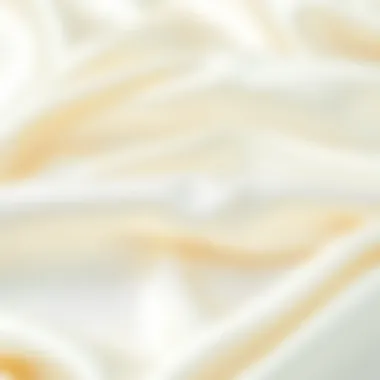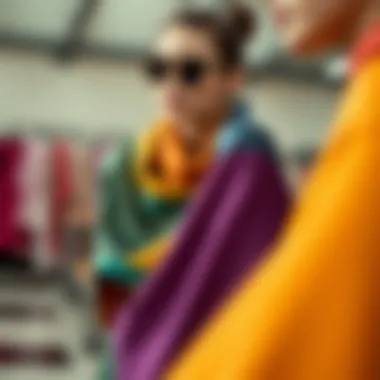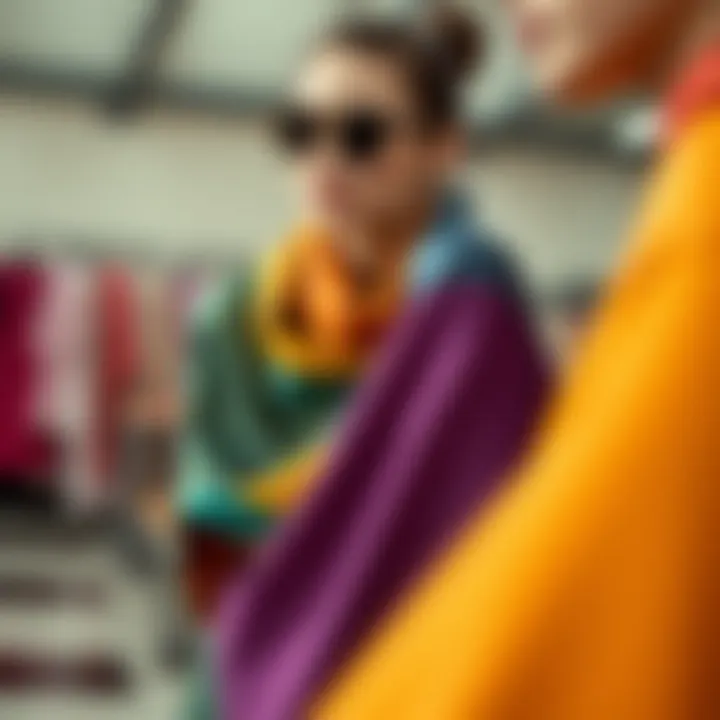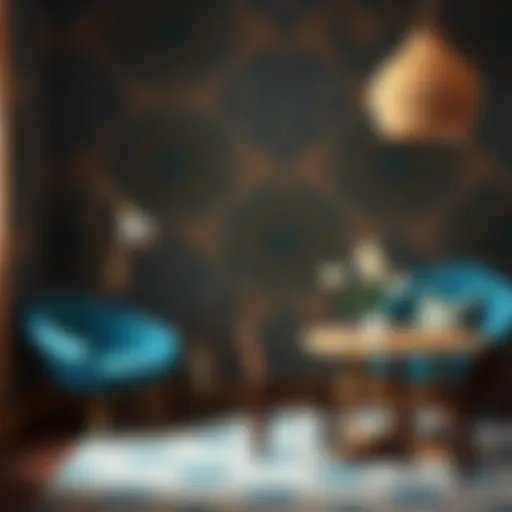Discovering the Wonders of Milk Silk Fabric


Intro
Milk silk fabric, a fascinating textile born from innovative processes, is capturing attention in the fashion world. This unique material is beginning to take its place alongside more traditional fabrics. With roots in both natural and synthetic realms, it boasts an impressive array of properties that appeal to a broad audience of designers, retailers, and fashion enthusiasts alike. In an industry that increasingly values sustainability, milk silk offers a refreshing alternative, allowing wearers to embody style while making environmentally conscious choices. The subsequent sections of this article will illuminate various aspects of milk silk, including its origins, properties, and styling techniques, enabling readers to deepen their understanding and appreciation of this innovative fabric.
Current Fashion Trends
As we meander through the ever-evolving landscape of fashion, milk silk fabric stands as a testament to the strengths of modern textile development. Its character resonates well with current trends that marry sustainability and style—two attributes now at the forefront of consumer preferences.
Seasonal Must-Haves
With the change of seasons comes an array of fashion choices. Milk silk is emerging as a seasonal staple due to its lightweight feel and luxurious drape. Here are some standout categories where this fabric shines, particularly in spring and summer collections:
- Flowy Dresses: Milk silk lends itself beautifully to flowing silhouettes that catch the wind just right, ideal for warm weather outings.
- Chic Blouses: Paired with tailored trousers or skirts, these blouses show off the fabric’s vibrant colors and patterns.
- Lightweight Scarves: A versatile accessory, milk silk scarves can easily elevate any outfit, adding a touch of sophistication.
Iconic Styles to Embrace
When discussing contemporary fashion, certain styles become synonymous with the materials they are made from. For milk silk, think of these iconic looks that effortlessly incorporate its unique qualities:
- Layered Ensembles: Combining milk silk with other fabrics creates textures that make an outfit pop.
- Monochromatic Looks: Using varying shades of one color brings out the rich potential of milk silk’s sheen.
- Athleisure: With its breathable nature, milk silk is perfect for sporty chic outfits, uniting comfort with elegance.
"Incorporating milk silk in your wardrobe not only elevates your style but also reflects a commitment to eco-friendly fashion."
Style Tips and Tricks
Navigating the world of style can be a maze, but understanding how to work with specific fabrics can ease the journey. Milk silk claims its territory as a versatile fabric, and with the right strategies, it can become a wardrobe favorite.
Mixing and Matching Outfits
One of the keys to styling milk silk effectively lies in its compatibility with other materials. Consider these tips for mixing and matching:
- Contrast Textures: Pair milk silk with denim or leather to create a balanced aesthetic.
- Layer Wisely: Utilize milk silk blouses under structured jackets to add softness to a tailored look.
Care and Maintenance of Clothing
While milk silk is luxurious, it requires a bit of tender loving care. To keep your garments in tip-top shape:
- Gentle Washing: Hand wash or use a delicate cycle with mild detergent to preserve the fabric's texture and color.
- Air Dry: Avoid the dryer—lay the items flat to dry away from direct sunlight.
For further information on fabric care, many resources are available. Here is a helpful link for care tips.
As we traverse through the nuanced terrain of milk silk, it’s vital to embrace its potential while understanding its nuances. From crafting awe-inspiring outfits to making choices that resonate with your environmental values, milk silk fabric embodies the forefront of sustainable fashion.
Prologue to Milk Silk Fabric
Milk silk fabric is emerging as a noteworthy player in the textile industry, especially for those attuned to sustainable fashion. This unique material, derived from the proteins found in milk, represents a fascinating intersection of innovation and practicality. It’s not just another fabric; it’s an embodiment of how we can rethink textile production in a world yearning for sustainability.
Definition and Characteristics
Milk silk is crafted from casein protein, a derivative of milk, which lends the fabric its name and specific characteristics. Known for its soft texture and sheen that mimics traditional silk, milk silk also stands out for other reasons:
- Lightweight and Breathable: Despite its delicate feel, milk silk is remarkably durable, making it suitable for a variety of garments.
- Hypoallergenic Properties: The natural fibers of milk silk make it less likely to irritate the skin, which is particularly appealing for sensitive individuals.
- Moisture-Wicking Capabilities: This fabric can absorb and evaporate moisture, providing comfort in various climates, adding to its utility in activewear as well as everyday apparel.
To those familiar with traditional fabrics, these attributes underscore milk silk’s appeal. It's a fabric that not only feels luxurious but also serves a functional purpose in dressing, bridging the gap between comfort and style.
Historical Context
The rise of milk silk doesn’t just pop up overnight. Its history weaves through the development of alternative fabrics as society began to seek more sustainable methods of production. Originally, the concept was born in the mid-20th century, coinciding with a growing awareness of environmental impact and a push for sustainable textiles.
As folks began experimenting, casein fibers were initially used in textiles as early as the 1930s, but it was not until later that significant investment and interest took hold. During the 1990s and 2000s, advancements in technology allowed for better processing techniques, spurring manufacturers to explore new avenues for fabric production. The sustainable revolution in fashion, coupled with evolving consumer preferences, has breathed new life into milk silk, marking its transition from obscurity to a sought-after choice among eco-conscious designers and consumers alike.
"In a world where sustainability is no longer a choice but a necessity, fabrics like milk silk pave the way for innovative practices that benefit both industry and environment."
The transition towards utilizing milk silk fabric reflects a broader shift in the textile industry, where creativity meets responsibility. Its unique origins and characteristics position it as not only an innovative textile choice but also as a symbol of the possibilities that lie in marrying sustainability with style.
The Production Process
The production of milk silk fabric is a crucial element that defines its unique properties and market viability. From the sourcing of raw materials to the intricate manufacturing techniques employed, understanding this process provides insight into why milk silk is regarded as not only a sustainable choice but also a versatile fabric highly favored in contemporary fashion. Knowing the full spectrum of this production allows stylists and designers to appreciate its potential and integrate it into their collections effectively.
Sourcing Raw Materials


Sourcing for milk silk starts with the milk proteins, primarily casein, extracted from cow's milk. This protein is spun into fibers, giving the fabric its unique feel and texture. Given that dairy farming is prevalent, the by-product of milk production offers an abundant and sustainable resource.
However, sourcing isn't just about quantity; quality matters tremendously. The protein needs to be extracted with minimal environmental impact, emphasizing the importance of ethical farming practices. There’s a growing awareness among consumers regarding the origins of their materials, and manufacturers must keep this in mind. Farmers who use organic practices not only contribute to better quality products but also cater to a more conscious market.
Additionally, local sourcing can reduce transportation emissions, further dialing down the environmental footprint. This labor-intensive practice lays a solid foundation for everything that follows and is a vital consideration for producers focused on sustainable fashion.
Manufacturing Techniques
When it comes to turning raw milk proteins into fabric, several innovative manufacturing techniques come into play. The process generally involves:
- Filtration and Drying: The extracted casein is first filtered and then dried to produce a powder.
- Dissolving and Spinning: The powdered casein is mixed with water and some other natural substances before being extruded through a spinneret into fibers. This is a pivotal moment, as it truly defines the fabric’s texture and handle.
- Weaving and Finishing: These fibers are then woven into fabric using traditional weaving methods. Post weaving, finishing processes like dyeing or texturizing are applied, often utilizing eco-friendly dyes that do not harm the environment.
The technologies employed vary, but advancements in the field, including the development of water-efficient and energy-saving machines, have shown to enhance the processing stage. As fashion evolves, precision and creativity in these manufacturing techniques not only satisfy a technical requirement but also play a significant role in design possibilities. This flexibility allows designers to experiment with textures, patterns, and applications that can meet customer preferences in diverse markets.
Quality Control Measures
Quality control is vital at every stage of milk silk production to ensure that the final product meets the expectations of designers and consumers alike. Several measures are in place, including:
- Raw Material Testing: Before production begins, rigorous tests are conducted on the sourced milk proteins to assess purity levels and general quality.
- Monitoring Production Conditions: During manufacturing, conditions like humidity and temperature must be controlled to ensure that the fibers retain their intended properties.
- Final Fabric Assessments: After weaving, each batch of fabric goes through a quality assessment to check for consistency in color, strength, and texture.
In addition to these measures, third-party certifications and audits may be sought to enhance credibility in the marketplace. For instance, certifications can not only help with transparency but also communicate sustainable practices to consumers.
Understanding the production process of milk silk sheds light not just on the craftsmanship involved but also on the fabric's sustainability claims, allowing stylists and designers to make informed choices in their work. As the market for sustainable fashion continues to grow, aligning product quality with ethical sourcing can give garment makers an edge, ensuring that their designs aren't just fashionable but responsible as well.
Comparative Analysis with Other Fabrics
When stepping into the vibrant world of textiles, a comparative analysis allows us to understand where milk silk fabric stands among its peers. It’s essential to explore how milk silk stacks up against traditional fabrics like cotton and luxury materials like silk. Analyzing these fabrics not only highlights milk silk’s unique qualities but also informs designers and retailers about potential applications and consumer preferences. This section sheds light on the significant differences and similarities, helping fashion enthusiasts make informed choices.
Milk Silk vs. Cotton
Milk silk, a product that marries the dairy industry with textiles, offers an intriguing alternative to cotton. While cotton is lauded for its breathability and comfort, milk silk brings to the table a slight sheen and a softness that many find appealing. Here’s a closer look at their differences:
- Comfort: Both fabrics are known for their comfort, but milk silk tends to feel smoother against the skin. It offers a luxurious touch that cotton might lack, especially when its in a fine weave.
- Absorbency: Cotton excels in absorbency, making it ideal for casual wear especially in warm climates. Milk silk tends to be less absorbent but can provide a soft drape that enhances garments’ styles.
- Care: Laundry days can be a hassle with cotton sometimes fading or shrinking after washes. Milk silk, on the other hand, often holds its shape better, thanks to its synthetic components.
These factors make milk silk a favorable choice for fashion applications that prioritize elegance and fluidity.
Milk Silk vs. Polyester
When comparing milk silk to polyester, the first distinction that pops out is their origins. Polyester is synthetic through and through, while milk silk boasts a more natural touch, derived from milk protein. Here’s what this comparison brings forward:
- Sustainability: Milk silk is more appealing for eco-conscious consumers. The use of dairy waste opens the door to sustainable practices that polyester, derived from petroleum, simply cannot offer.
- Feel and Look: Polyester is often criticized for its synthetic feel, particularly in low-quality weaves. Milk silk, however, mimics the softness and luxurious sheen of silk, adding a significant edge over polyester in terms of tactile elegance.
- Durability: While polyester is known for its durability and resistance to wrinkles, milk silk also promotes longevity through proper care, although it might not stand up to harsh wear and tear as well as polyester does.
Fashion designers might choose milk silk over polyester for collections that emphasize sophistication while subtly addressing sustainability.
Milk Silk vs. Silk
Silk, the luxury fabric known for its luster and smoothness, is the gold standard in many wardrobe staples. However, milk silk poses some compelling arguments against traditional silk:
- Cost: Natural silk can put a dent in one’s wallet due to high production costs. Milk silk, with its innovative production methods, offers a budget-friendly option without sacrificing too much on quality.
- Care requirements: Silk demands delicate handling, including dry cleaning, to maintain its integrity. Milk silk typically requires less fuss, allowing for easier care routines that can appeal to a broader market.
- Environmental Impact: While silk production can be resource-intensive, milk silk presents a greener alternative by utilizing milk waste, thus contributing to sustainability efforts.
"In the world of fabrics, exploring beyond the traditional opens doors to creativity and sustainability that matter in modern fashion."
Environmental Impact
The environmental implications of milk silk fabric are worth unpacking, especially in today’s climate-conscious market. As consumers grow increasingly aware of what they wear and its impact on the planet, the benefits—and drawbacks—of milk silk fabric become critical points of discussion. Often under the radar compared to more prominent fabrics, milk silk can play a vital role in sustainable fashion. Here’s why it matters.
Sustainable Aspects of Milk Silk
Milk silk fabric offers a unique blend of sustainability and luxury, resulting from its production method. Sourced from casein, which is a protein derived from milk, the fabric does not use harmful chemicals in its creation. This entails that the textile is less polluting than synthetic alternatives like polyester. One crucial aspect is that milk silk fabric is made from a by-product of the dairy industry, thus repurposing waste into something valuable. It’s kind of like turning lemons into lemonade, but in this case, it’s all about fashion.
Here are a few sustainable benefits of using milk silk in the fashion industry:
- Resource Efficiency: Milk silk production often requires fewer natural resources compared to traditional silks.
- Lower Carbon Footprint: Due to the efficient processes involved in the manufacturing of milk silk, it can contribute to a reduced carbon footprint.
- Resource Repurposing: Utilizing milk waste addresses the challenges of dairy by-products, showcasing an innovative use of resources.
The potential for creating a positive impact in textile manufacturing makes milk silk an attractive option for designers and brands looking for environmentally friendly alternatives.
Biodegradability and Waste Management
One of the standout features of milk silk is its biodegradability. Unlike synthetic fabrics, which can take centuries to decompose, milk silk is largely organic, allowing it to break down naturally over time. When considering waste management, this is a significant factor. In the era of fast fashion, the disposal of clothing frequently leads to heaps of textile waste in landfills.
- Natural Breakdown: Given its organic composition, milk silk will decompose more quickly, leaving a minimal footprint on the environment.
- Circular Fashion: Encouraging a closed-loop approach in the fashion cycle, this fabric aligns closely with the principles of sustainable living. Adopting milk silk can help brands pivot towards greener practices, supporting a circular economy where materials are reused and recycled.


In a nutshell, the environmental impact of milk silk fabric provides compelling reasons for its integration within sustainable fashion. As the industry progresses, embracing materials that not only appeal aesthetically but also support environmental health is critical. Armed with these insights, stylists and designers can make informed choices that contribute to a greener future in fashion.
“Sustainable fashion is not a trend; it’s a movement towards a more responsible industry. Milk silk might just be one of the fabrics to watch.”
For more on sustainable fabrics, resources like Wikipedia and Britannica offer extensive information.
Fashion Applications of Milk Silk
The significance of milk silk fabric in the fashion industry cannot be overstated. Known for its versatile properties, milk silk opens up a realm of creative possibilities for designers and retailers alike. Its unique characteristics blend safety and style, making it an ideal choice for various garments. This section will explore the diverse applications of milk silk, highlighting specific elements that showcase its benefits in different fashion categories.
Garments Made from Milk Silk
Milk silk fabric is gaining traction among fashion designers for creating a variety of garments. Its soft texture and breathable nature make it an excellent candidate for everyday wear. Here are some key items often produced using milk silk:
- T-Shirts and Blouses: The lightweight nature of milk silk makes it perfect for comfortable yet stylish tops. Its gentle drape enhances body shape without clinging.
- Dresses: From casual sundresses to elegant maxi dresses, milk silk enhances femininity while ensuring comfort.
- Loungewear: With an increasing trend toward comfort in fashion, milk silk loungewear provides cozy yet chic alternatives.
Additionally, the fabric's ability to retain color well means that vivid prints can stand the test of time. Thus, garments made from milk silk not only look appealing but also hold their beauty through countless washes.
Milk Silk in Activewear
The activewear segment has found a notable ally in milk silk. Many athletic brands are incorporating this fabric for a variety of essential reasons:
- Moisture-Wicking Properties: Milk silk naturally absorbs moisture, drawing sweat away from the skin, crucial for intense workouts.
- Stretch and Flexibility: Milk silk’s elasticity adds comfort for movements. A high range of motion is necessary for active pursuits, and this fabric delivers.
- Antimicrobial Qualities: The fibers offer resistance to bacteria, making it suitable for people on the go who may not have time to wash clothes after every use.
Activewear made from milk silk provides both performance and style, appealing to those who seek fashionable yet functional fitness apparel. Designers can creatively blend this material with others to enhance performance features while maintaining a fresh aesthetic.
Use in Evening Wear
In the realm of evening wear, milk silk offers a unique advantage: luxurious appeal while remaining versatile and practical. Let's discuss how this fabric shines in formal settings:
- Elegant Draping: Milk silk flows gracefully, making it an ideal choice for gowns and cocktail dresses. The way it catches the light adds an element of sophistication to evening attire.
- Variety of Styles: From sleek and fitted silhouettes to more flowing designs, this fabric adapts well to emerging trends, allowing designers to produce garments that fit the modern woman's needs.
- Comfort Without Sacrifice: Traditionally, elegant evening wear comes at the expense of comfort. With milk silk, wearers can enjoy a soft fabric against their skin while still exuding glamour.
"The allure of evening wear made from milk silk lies in its duality: strikingly beautiful yet incredibly comfortable."
As consumer awareness grows regarding both style and comfort, milk silk evening wear is becoming a favored choice, contributing to a shift in how women perceive formal attire.
In summary, the applications of milk silk in fashion demonstrate tremendous potential. Its ability to cater to different needs—from casual garments to high-end evening wear—positions it as a fabric worth exploring for designers and retailers. As the fabric continues to gain traction, understanding its uses could lead to exciting innovations and trends in the fashion landscape.
For further insights into sustainable fabrics, exploring sources like Wikipedia or Britannica can be valuable.
Care and Maintenance
The care and maintenance of milk silk fabric are pivotal to ensuring its longevity and preserving its unique characteristics. Given its innovative nature, proper handling can significantly enhance the performance and aesthetic of garments made from this fabric. As a material derived from milk proteins, milk silk exhibits properties that differ from conventional fabrics, making it essential to adopt tailored care practices.
Taking diligent care of milk silk not only benefits the look and feel of the fabric but also supports sustainable fashion choices by minimizing waste. Practicing good maintenance habits helps maintain the integrity of the fibers, ensuring the garment retains its softness and luxurious drape over time. Below, you'll find thorough guidelines on washing, ironing, and storing milk silk products, enabling you to enjoy their elegance and functionality for years to come.
Washing Instructions
When it comes to washing milk silk, the mantra is gentle and careful. The delicate nature of the fabric demands a mindful approach to cleaning. Here are key pointers on washing milk silk:
- Hand Washing is Best: To maintain the fabric's qualities, immerse it gently in cool water with a mild detergent designed for delicate fibers. Avoid harsh chemicals that can strip away the fabric's natural softness.
- Short Soak Times: Don't let your milk silk soak for too long; a quick 5 to 10 minutes should suffice. Prolonged exposure to water may weaken the fibers, diminishing the garment’s quality.
- Avoid Spinning: If you prefer machine washing, utilize the gentle cycle and place items in a mesh laundry bag. However, refrain from using the spin cycle; causing unnecessary agitation will lead to wear and tear.
- Rinse with Care: Thoroughly rinse with cool water until all detergent is removed. Residual chemicals can affect the fabric and provoke irritation on the skin.
- Air Dry Only: Never wring or twist the fabric to remove excess water. Instead, lay flat on a clean, dry towel to absorb moisture and then hang it to air dry away from direct sunlight to preserve color and texture.
By following these washing guidelines, you can keep your milk silk garments in prime condition, ensuring they remain visually stunning while providing comfort and utility.
Ironing and Storage Tips
Once your milk silk garments are washed and dried, proper ironing and storage become crucial for maintaining their elegance. Here’s how to navigate these two aspects:
- Ironing with Precision: To avoid damaging the fabric, always iron on the lowest heat setting, ideally while the fabric is still slightly damp. If it’s too dry, lightly spritz with water; using a pressing cloth can also shield the fabric. Be cautious to not apply direct heat for prolonged periods, as it may scorch the fibers.
- Folding Instead of Hanging: When storing milk silk, opt for folding rather than hanging, as this prevents the fabric from stretching. Place folded items in a breathable cotton bag to minimize odors and moisture accumulation.
- Considerations for Long-term Storage: If you intend to store milk silk garments for longer periods, add cedar blocks to deter moths and other pests. Ensure the storage area is cool and dry to further protect the fabric's integrity.
- Avoid Heavy Objects: When stacking items, be mindful of weight. Heavy objects on top of milk silk storage could create unnecessary creases and shape distortions.
These steps, though simple, allow your milk silk garments to shine bright for many seasons to come.
Remember: Investing time in caring for your milk silk fabrics reinforces your commitment to sustainable fashion and enhances your personal style.
By integrating these care practices into your routine, you can not only extend the life of your milk silk garments but also uphold their luxurious appeal, reflecting both sophistication and sustainability in your fashion journey.
Market Trends and Consumer Preferences
Understanding market trends and consumer preferences is basically at the heart of today’s fashion industry, especially when it comes to innovative materials like milk silk. As eco-conscious attitudes rise, the demand for sustainable fabrics has surged, driving designers and retailers to rethink their strategies and offerings. This section explores how milk silk's unique characteristics align with evolving consumer expectations, spotlighting its growing appeal among fashion insiders and the likelier customer base.
Popularity Among Designers


Milk silk fabric has garnered attention from designers looking to blend sustainability with aesthetic appeal. Its soft texture, draping capabilities, and rich hues allow for highly creative and adaptable designs. Not to mention, designers appreciate the fabric’s ability to maintain a luxurious finish while ensuring that their creations are eco-friendly. A notable example can be seen in high-fashion brands that are increasingly incorporating milk silk into their collections.
- High-profile designers have leveraged milk silk for evening gowns, reflecting a newfound commitment to eco-consciousness without sacrificing style.
- Collaborative collections with emerging fashion talent highlight the fabric's versatility. Some young designers favor milk silk for activewear lines, responding to a growing customer demand for functional yet stylish athletic wear.
- The fabric has made its way to sustainable fashion shows, where it often represents the future of textile innovation.
Despite its benefits, designers must tread carefully. The higher production costs can pose financial challenges. However, many believe that the potential market for sustainable luxury offers a long-term advantage, making the initial investment worthwhile.
Consumer Awareness and Demand
There’s a palpable shift in consumer behavior as individuals become increasingly educated about sustainability. Today’s shopper isn’t merely satisfied with what looks good; they also want products that do good. Milk silk resonates well with this mindset because it combines practicality with elegance. However, much of its success hinges on effective communication about its properties and benefits.
- Consumers are actively seeking information about the origin and sustainability of textiles, making transparency vital for brands using milk silk. This awareness is pushing retailers to highlight the environmental benefits of this fabric clearly.
- Research shows that products marketed as sustainable often experience a significant boost in purchase intent. With milk silk, brands that share their ethical sourcing and manufacturing processes are likely to attract a more engaged and loyal customer base.
- Effective storytelling around the fabric can enhance its appeal. For instance, sharing the journey from raw materials to finished garment can create a connection with consumers, linking their values to their purchasing choices.
In summary, the trends indicate that consumers are ready to embrace milk silk, provided they are reassured about its sustainable aspects. This demand not only empowers designers to create responsibly but also pushes the entire industry towards more sustainable practices.
"Sustainability isn’t just a buzzword; it's a way for the fashion world to reinvent itself through innovation, and milk silk is the canvas on which this is painted."
Incorporating milk silk fabric into collections is not just a trend; it��’s a response to changing demands that signals a more conscious approach to fashion. For those in the industry—designers, stylists, and retailers—the need to keep pace with these trends is critical. Studying consumer preferences equips brands with the insights needed to craft collections that resonate deeply, ensuring relevance in an ever-evolving market.
Challenges and Considerations
When navigating the realm of milk silk fabric, industry stakeholders face a variety of challenges that warrant attention. Understanding these challenges is pivotal for manufacturers, designers, and consumers alike. It becomes crucial to consider not just the allure of this innovative fabric, but also the hurdles intertwined with its production, procurement, and use in fashion. Let's dive into the specifics, shedding light on the cost implications and longevity concerns that can influence decision-making in this field.
Cost Implications for Manufacturers
The cost structure of manufacturing milk silk is intricate. This fabric, derived from casein protein found in milk, presents some distinct financial factors. First off, sourcing raw materials can be a bit on the pricey side. Manufacturers need to ensure they have a consistent milk supply, which can drive up costs, especially in regions where dairy farming is not prevalent. This situation often leads to a domino effect—higher production costs may trickle down to the retail level, potentially making milk silk products less appealing to price-sensitive consumers.
Moreover, the advanced technologies employed in transforming milk into usable fibers require initial investment, which can weigh heavily on smaller businesses.
- Material Sourcing: Depending on the regional availability of milk, procurement costs can fluctuate significantly.
- Production Technology: Up-to-date machinery for processing milk silk fibers can also result in increased startup expenses.
Ultimately, if manufacturers don't strike a balance between quality and pricing, they risk alienating potential buyers who may opt for cheaper alternatives.
Longevity and Durability Issues
While milk silk is hailed for its softness and luxurious feel, durability issues can sometimes raise eyebrows. The organic nature of this fabric means it may not possess the same resilience as synthetic alternatives. For instance, when exposed to rough handling or extensive wear, milk silk garments can show signs of wear and tear more quickly than polyester or traditional silk.
Additionally, the longevity of milk silk is influenced by its sensitivity to moisture and sunlight. If proper care isn't taken, the fabric can degrade over time, affecting its appearance and structural integrity. This is crucial information for both consumers and designers, as longevity is often equated with quality in the fashion industry.
To encapsulate the concerns regarding durability:
- Sensitive Nature: Milk silk's organic composition can lead to wear if not properly cared for.
- Environmental Exposure: Factors like moisture and UV exposure can accelerate fabric degradation.
Future Directions in Milk Silk Fabric Research
The continual evolution of fabric technologies remains a pivotal aspect of the textile industry, and milk silk fabric is no exception amidst this ever-changing landscape. As consumers grow increasingly discerning regarding sustainability and functionality, the focus on innovative methodologies and applications within milk silk fabric becomes paramount. This section delves into the future trends and directions in milk silk research, focusing primarily on innovations in fabric production and potential uses beyond clothing. This exploration is relevant as it seeks to enhance the quality, sustainability, and versatility of milk silk, making it an attractive choice for both designers and consumers.
Innovations in Fabric Production
Finding efficient production techniques for milk silk is essential for meeting the rising demand in the fashion industry. Currently, producers are honing in on cutting-edge practices that both elevate quality and reduce environmental impact. One noteworthy avenue of exploration involves the utilization of advances in biotechnology, including genetically engineered microorganisms that can produce milk protein fibers.* This approach could not only enhance yield but also improve the consistency of fabric performance. Additionally, improvements in nanotechnology are making waves. Implementing nano-coatings can enhance attributes such as water resistance, UV protection, and overall fabric durability.
These innovations are particularly significant in improving the washing and maintenance properties of milk silk. With effective treatment techniques, the fabric could maintain its qualitative characteristics without excessive reliance on harsh chemicals in the cleansing processes. If manufacturers can consistently produce these superior variants, we might see not just a rise in market demand but a redefinition of what consumers expect from sustainable fabrics.
Potential Uses Beyond Clothing
The versatility of milk silk fabric extends well past apparel into several unexpected realms. As designers and researchers explore the fabric's properties more thoroughly, potential applications in home décor and industrial settings are becoming intriguing prospects. Here are some noteworthy directions:
- Home Textiles: Milk silk can be cleverly used in items such as curtains and upholstery, owing to its luxurious feel and drape. The sustainable properties of the fabric could appeal to those wanting an eco-friendly home, making it a potentially lucrative market.
- Personal Care Products: There's evidence that milk silk fibers possess natural antibacterial properties, suggesting an opportunity for inclusion in personal hygiene articles like bed linens and pillowcases, which could promote skin health.
- Healthcare Applications: Further research into the antimicrobial qualities heralds potential use in medical textiles. This could range from hospital garments to wound dressings, marrying comfort with health benefits.
The exploration into these areas highlights the uncharted territory milk silk fabric could cover in the future. The intertwining of innovation with sustainability not only encourages ethically-conscious consumerism but also broadens the horizons of what textile production looks like, enhancing the industry as a whole.
Ending
In wrapping up our discussion around milk silk fabric, its significance in the realm of textiles cannot be overstated. Understanding this remarkable material offers insights into not just the fabric's applications, but the moral imperative of sustainability in fashion today. As we've explored throughout, milk silk is a unique fabric that provides a blend of comfort, breathability, and eco-friendliness, making it an attractive choice for both consumers and creators alike.
Summarizing Key Insights
Milk silk stands out among various fabrics for several reasons:
- Eco-Friendly Production: Made from the by-products of the dairy industry, it transforms potential waste into a valuable resource, supporting sustainable practices in fashion.
- Versatility: From casual wear to high-end evening dresses, milk silk's adaptability suits a range of styles and designs, appealing to diverse audiences.
- Comfort and Style: Its soft and smooth texture mirrors that of traditional silk but comes with the added benefit of being lightweight and breathable, enhancing wearability.
In summary, milk silk is not merely a trend but a viable option that aligns with a growing demand for sustainability in fashion. Its quality and shape retention ensures longevity, making it a practical choice too.
Final Thoughts on Milk Silk's Role in Fashion
As we look to the future, the role of milk silk in fashion appears optimistic. It not only satisfies the aesthetic cravings of today's consumers but also supports the broader conversation about environmental responsibility in the industry. With the fashion world continuously grappling with issues like fast fashion and waste, fabrics like milk silk present a savory alternative that encourages conscious thinking among designers and consumers.
Fashion designers and retailers should consider incorporating milk silk into their collections, both as a statement of innovation and a commitment to sustainability. As more consumers prioritize eco-friendly choices, understanding and adopting materials like milk silk can set brands apart in a crowded market. Ultimately, the future of textiles may well reside in thoughtful, sustainable choices that delight while respecting our planet.







